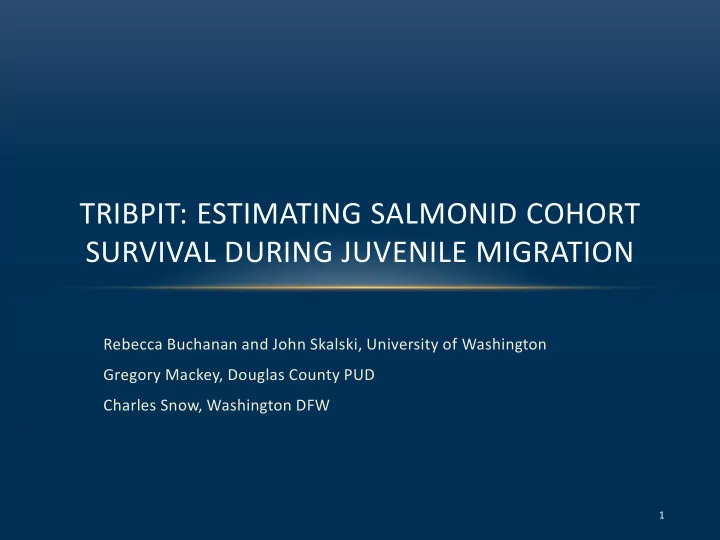

TRIBPIT: ESTIMATING SALMONID COHORT SURVIVAL DURING JUVENILE MIGRATION Rebecca Buchanan and John Skalski, University of Washington Gregory Mackey, Douglas County PUD Charles Snow, Washington DFW 1
COHORT SURVIVAL: INTRODUCTION Historical focus of survival • monitoring: annual migration through hydrosystem System survival • LGR-LGR SAR • Great! But • Misses survival to • hydrosystem How to relate migration • performance to brood year? • Variation in age at initiation of migration 2
COHORT SURVIVAL: INTRODUCTION Cohort survival: probability of • subyearling fish surviving to eventually reach … Mainstem river • Hydrosystem • McNary Dam (etc.) • Defined for cohort from a brood • year Accounts for variation in age • at migration Includes • • Initiation of migration • Survival from rearing (tagging) grounds to hydrosystem 3
OUTLINE Introduction: Cohort Survival • Development of Analysis Model • Case Study: Twisp River Steelhead, 2010 cohort • Data and Software • Results and Conclusions • 4
DEVELOPMENT OF ANALYSIS MODEL: GENERALIZED LOWTHER-SKALSKI MODEL 5
SIMPLE POPULATION: CJS MODEL λ =S 3 P 3 P 1 P 2 S 1 S 2 Rel 6
COMPLEX POPULATION: BRANCHING MODEL λ =S 3 P 3 S 1 P 1 S 2 P 2 Year 1 Rel Year 2 Year 3 7
COHORT BRANCHING MODEL Model estimates transition probability λ =S 3 P 3 • Year-specific probability S 1 P 1 S 2 P 2 of getting from one site to another • Includes: Year 1 Rel • Migration and survival • Delay and survival Year 2 Year 3 8
COHORT SURVIVAL TO SITE 1 Year 1 Rel Year 2 Year 3 9
COHORT SURVIVAL TO SITE 2 Year 1 Rel Year 2 Year 3 10
COHORT BRANCHING MODEL: ANNUAL RELEASES OVER AGE CLASSES Year 1 Rel 1 Year 2 Rel 2 Year 3 Rel 3 11
DETECTION SITES AND DATA Detection sites • • Instream PIT-tag detectors (juvenile) • Juvenile Bypass Systems and other dam sites • Estuary Towed Array • Detection probabilities: not tiny Data • • PIT-tag interrogation data • Detected where and when • Multiple observation years • DART query • Age data – identify the cohort 12
CASE STUDY: TWISP RIVER STEELHEAD 13
TWISP RIVER STEELHEAD 2010 – 2012 (July – October): • 5,422 juvenile O. mykiss tagged • CSS Study • Hatchery effectiveness monitoring for • Douglas PUD 14
TWISP RIVER STEELHEAD Brood Year: 2010 • Tagging: Hook and line, electroshock, • rotary screw trap • 2010: 211 • 2011: 759 • 2012: 514 Age data • • Scale samples (WDFW) • < 90 mm: subyearlings (fall) or yearlings (July) Detection Sites • • LMR = Lower Methow River – couldn’t use • Rocky Reach, McNary, John Day 15
DART DATA QUERY: WWW.CBR.WASHINGTON.EDU/DART/QUERY/PIT_BASIN_BRANCHING 16
TAGGING AND OBSERVATION DATA 17
PROGRAM TRIBPIT WWW.CBR.WASHINGTON.EDU/ANALYSIS 18
SITES AND YEARS CONFIGURATION 19
RESULTS: TRANSITION PROBABILITIES 20
TWISP STEELHEAD: COHORT SURVIVAL To Rocky Reach: To McNary: 0.0478 0.0283 (SE = 0.0025) (SE = 0.0139) 21
DATA REQUIREMENTS PIT-tag subyearlings • Age the fish – all the fish you want to use to estimate cohort survival • Sample size • • Sample size of subyearlings is key • Large enough to represent every migration year for cohort • Tributary Survival SampleSize (Columbia Basin Research) 22
CONCLUSIONS Cohort survival is the probability of a subyearling surviving to a downstream • location Proportions of fish outmigrating each year • Survival for each age class • Performance metric from Bi-Op • What we learn from cohort survival and TribPit • Survival to the hydrosystem • Where are fish overwintering • Age structure of migrants • Applications • Steelhead juvenile outmigration • Fall Chinook salmon • Spring Chinook salmon (non-natal rearing areas) • Software: www.cbr.washington.edu/analysis • 23
THANKS Software: • • Jim Lady and Susannah Iltis, Columbia Basin Research, University of Washington Consultation: • • Andrew Murdoch, Todd Miller – WDFW • Tim Copeland, Brett Bowersox, Nick Davids – IDFG • Scott Favrot – ODFW • Jody White – QCI • Joe Zendt – Yakama Nation • Rick Orme – Nez Perce Tribe • Josh Murauskas – Anchor QEA • Pat Connolly – USGS Funding: Bonneville Power Administration • 24
Recommend
More recommend